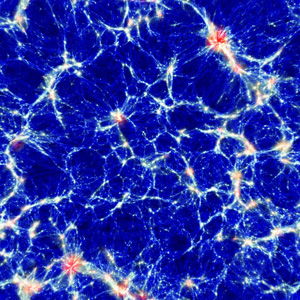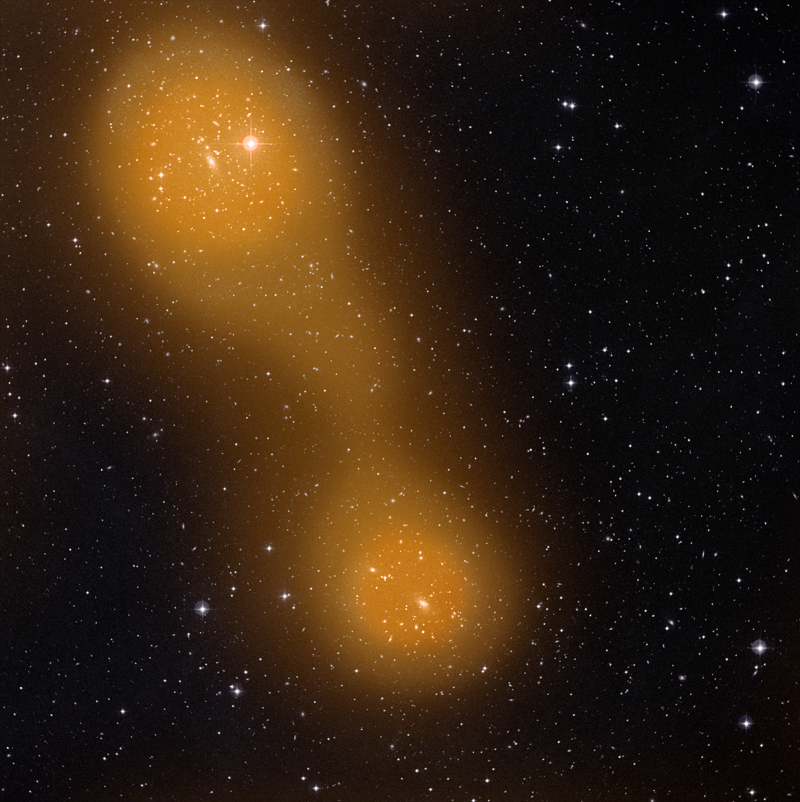| Basic Information | |
| What is this? | A bridge of hot gas between two clusters of galaxies |
| Where is it in the sky? | In the constellation of Aries |
| How big is it? | The clusters contain hundreds of galaxies, and the bridge of gas is around 10 million light years long |
| How far away is it? | Around 1 billion light years |
| What do the colours represent? | The galaxies are seen in visible as tiny dots, with the clusters of galaxies easily seen. The hot gas detected by Planck is seen as the orange region |
Downloads
Planck has made the first conclusive detection of a bridge of hot gas connecting a pair of galaxy clusters across 10 million light-years of intergalactic space. This gas is thought to play an important role in the formation of galaxies and galaxy clusters, but has never been observed before.
Planck’s primary task is to capture the most ancient light of the cosmos, the Cosmic Microwave Background, or CMB. This is light emitted nearly 14 billion years ago, just after the Big Bang, and has been travelling through space for all that time. As this faint light traverses the Universe, it encounters different types of structure including galaxies and galaxy clusters – assemblies of hundreds or thousands of galaxies bound together by their own gravity.
If the CMB light interacts with the hot gas permeating these huge cosmic structures, its energy distribution is modified in a characteristic way, a phenomenon known as the Sunyaev–Zel’dovich (SZ) effect, after the scientists who discovered it. This effect has already been used by Planck to detect galaxy clusters themselves, but it also provides a way to detect faint filaments of gas that might connect one cluster to another.

In the early Universe, filaments of gaseous matter pervaded the cosmos in a giant web, with clusters eventually forming in the densest nodes. Much of this tenuous, filamentary gas remains undetected, but astronomers expect that it could most likely be found between interacting galaxy clusters, where the filaments are compressed and heated up, making them easier to spot.
Planck’s discovery of a bridge of hot gas connecting the clusters Abell 399 and Abell 401, each containing hundreds of galaxies, represents one such opportunity. The clusters are around one billion light years away from us, but are separated by only 10 million light years. The presence of hot gas between these neighbouring clusters was first hinted at in X-ray data from ESA’s XMM-Newton satellite, and the new Planck data confirm the observation.
It also marks Planck’s first detection of inter-cluster gas using the SZ effect. By combining the Planck data with X-ray observations from the German satellite Rosat, which operated in the 1990s, the temperature of the gas in the bridge is found to be similar to the temperature of the gas in the two clusters – somewhere in the region of a scorching 80 million degrees Celsius.
Early analysis suggests the some of the gas could be due to the elusive cosmic web, the network of filaments of gas that that threads through the Universe and is responsible for the formation of the massive galaxy clusters we see today. This is probably also mixed with gas originating from the clusters themselves, pushed out by the intensity of the combined light of trillions of stars. A more detailed study, and the possible detection of gas bridges connecting other clusters, will help to provide a more conclusive answer.

The image on the right shows a computer simulation of the filmanetary cosmic web, seen as wispy orange structures. The densest parts of the cosmic web contain massive clusters of galaxies, seen in purple, and the hot gas stretching between them, seen in white. Many of the clusters in this simulated Universe are linked by bridges of hot gas, at many millions of degrees Celsius, and it is the existence of these bridges that Planck has confirmed in the real Universe.
The new finding highlights the ability of Planck to probe galaxy clusters to their outskirts and beyond, examining their connection with the gas that permeates the entire Universe and from which all groups of galaxies formed.
